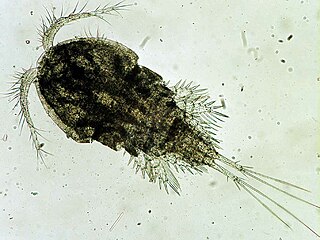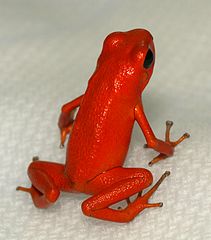Dwarf African Clawed Frogs, also known as Dwarf African Frogs (Hymenochirus boettgeri and H. curtipes) are very popular pets, yet few hobbyists attempt to breed them in captivity. Reproduction sometimes occurs spontaneously, but unless one is prepared, the eggs and tadpoles rarely survive. As both a lifelong frog enthusiast and career herpetologist, I find this to be a sad state of affairs. For these tiny aquatic frogs can be easily induced to breed and exhibit some of the amphibian world’s most amazing reproductive behaviors – including a circular egg-laying “dance” that may go on for 7 hours! The bizarre tadpoles are equipped with tubular mouths and swim in a head up position at the water’s surface, propelled by rapidly-beating tails. Looking somewhat like tiny skin-divers, rearing a tankful of these charming little amphibians is a most interesting and pleasurable undertaking.
Distinguishing the Species and the Sexes
Hymenochirus boettgeri and H. curtipes are the only species regularly available in the pet trade. Hymenochirus boettgeri has proportionally longer rear legs than H. curtipes, and its skin appears more granular. The tadpoles are easy to distinguish (please see below).
Females are larger than males, and they are positively rotund when carrying eggs. Males can be distinguished by their postaxillary glands, which appear as a tiny white bump behind each forearm.
Inducing Reproduction
Normal fluctuations in room temperature and a good diet are sometimes enough to induce breeding. However, if you wish to assure reproduction, a few simple steps should be followed.
A diet of brine shrimp and fish flakes may keep these frogs alive, but will rarely support breeding or long lives. Potential breeders should be supplied with a varied diet that includes Blackworms, enriched Brine Shrimp, Whiteworms, Daphnia, Mosquito Larvae, Springtails, Bloodworms, Glass Worms and other small invertebrates. Please see this article and post any questions below.
Dwarf African Frogs can be brought into breeding condition by a rapid or gradual lowering of the water level (to ½ of its former depth). After 2 weeks or so, refill the tank with de-chlorinated water that is approximately 5 degrees cooler than that already in the tank. Then, using a heater, allow the water temperature to rise to 82 F over a 7-10 day period.
After this “drought-flood cycle”, your males should begin issuing calls that sound somewhat like a ticking clock. They will also quite comically gesticulate by moving their arms about in what looks like a “practice embrace”. Soon they will begin to grasp at any frog in reach – if another male is grabbed, he will emit a growl-like release call and stiffen his rear legs. Receptive females will be grasped about the waist in an amphibian mating embrace known as amplexus.
A red or black bulb will allow you to observe the goings-on without disturbing the happy couples.
Amplexus and Egg-Laying
Most frogs utilize pectoral amplexus, wherein the male grasps the female just behind the arms. Male Dwarf African Frogs and others in the family Pipidae (which includes Surinam Toads and African Clawed Frogs) however, latch onto the area just above the female’s rear legs, a position known as inguinal amplexus.
During amplexus, the male frog changes the tone of his call and occasionally swipes his mate’s head with his clawed feet. Thus joined together, the pair swims from the aquarium floor to the surface, then back to the bottom, in a circular pattern. Eggs are deposited each time they reach the surface, much like their larger cousin, the Surinam Toad. They take a short rest on the bottom, and then repeat the cycle. The process is completed in 1-7 hours, and can include 50 -350 individual egg-laying trips to the surface; as many as 1,000 eggs may be deposited.
The Eggs
The tiny (2 mm diameter) eggs float and stick to aquatic plants. Those of H. curtipes are brownish in color; H. boettgeri eggs are a bit lighter. Adult frogs readily consume them, so it is best to carefully move the eggs to an aquarium that has been prepared beforehand or relocate the adults.
Eggs that remain floating have the best hatching success, followed by those attached to plants. Eggs that sink to the bottom rarely hatch. At 78 F, hatching can be expected in 1.5 – 2 days.
The water should be aerated via a filter, but strong currents must be avoided. Under-gravel or corner filters are ideal for both eggs and tadpoles.
The Tadpoles
The tadpoles will remain attached to various substrates by an adhesive gland for 5-6 days following hatching, and will not feed during this time.
H. curtipes tadpoles measure 4mm upon hatching, and are equipped with a long, tubular mouth. They glide about at the water’s surface in a most curious head-up position, propelled by the rapidly-beating tail. Infusoria and other tiny organisms are continually sucked into the mouth as the tadpoles motor about.
At 78 F, the hind legs will appear on day 28-32. The forelimbs are not seen until just before metamorphosis, which occurs on day 60-70. The newly-transformed frogs measure 1 cm in length.
The tadpoles of H. boettgeri are even smaller upon hatching, averaging a mere 2.5 mm in length. They can be distinguished from H. curtipes by their slimmer build, out-sized eyes and fully-pigmented tails. Although smaller than their relative, H. boettgeri tadpoles are more active and can take larger food items. They grow quickly, developing rear legs by day 12 and front legs by day 20. Transformation is usually complete at 30-32 days of age, at which point they measure 2 cm in length.
Feeding the Tadpoles
Dwarf African Frog tadpoles are confirmed carnivores. H. curtipes tadpoles need exceedingly small food items…even Daphnia are too large. A brightly-lit tank planted with Java Moss should be set up beforehand. Algae establish readily on Java Moss, and both will support infusoria, water fleas (Cyclops, please see photo) and other tiny organisms favored by the tadpoles. You can also collect minute invertebrates by adding pond water to your tank, or by sift through ponds and swamps with a brine shrimp net; be sure to check for dragonfly larvae and other predators.
H. boettgeri can be fed as described above, and will also accept Daphnia and newly-hatched brine shrimp. A brine shrimp hatchery will help keep them supplied with food…please post below for further information. Some breeders report that liquid fish fry foods are accepted, but I have not experimented with these.
Newly transformed frogs will accept chopped blackworms (a good staple) and other adult foods, as well as most of the tadpole foods mentioned above.
 That Reptile Blog – Reptile, Amphibian and Exotic Pet Care and Information
That Reptile Blog – Reptile, Amphibian and Exotic Pet Care and Information





